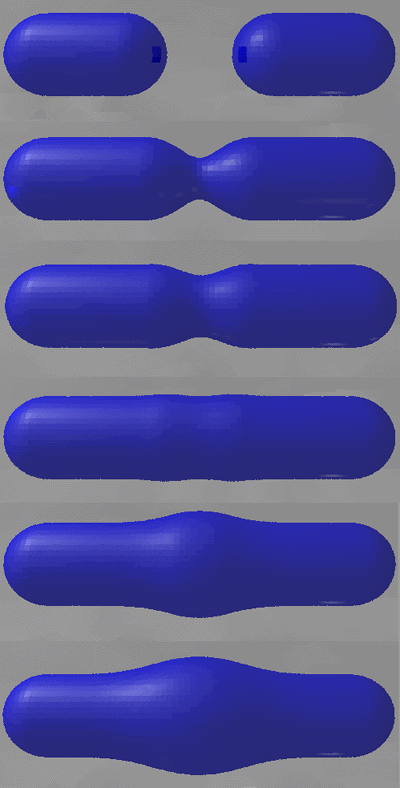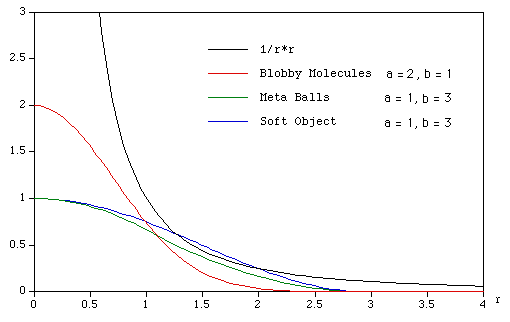Implicit surfacesAlso known as "Metaballs", "Blobbies", "Soft objects"
Written by Paul Bourke
IntroductionMost computer based 3D geometric modelling is done with basic primitives such as lines, planes, boxes, etc. Many smooth and deformable objects are difficult or inefficient to represent with such building blocks, even if primitives such as spheres or Bezier/spline surfaces are used. An increasingly popular approach has been the use of field functions in 3D, the surfaces being isosurfaces through the field. The following summarises three common methods for creating so called "implicit surfaces". That is, surfaces which are contours (isosurfaces) through some scalar field in 3D. There are three commonly used techniques each distinguished by their field functions. The field function determines the value at every point in space due to some underlying primitive geometric objects, normally points, line segments, and polygonally bounded planes. ExampleConsider the field function D(r) = 1/r2 and a number of control points in 3D space. r is the distance of a point in space to a particular control point. The total field strength at any point in space is the sum of the field strengths due to each control point. A contour can be drawn through this space resulting in a 3D surface. For example if there is a single control point different colour levels will result in spheres of different radius. If there are two control points the combined fields will interact, the resulting isosurface will bulge between the two control points depending on their relative distance apart. This is shown below for a range of control point distances. 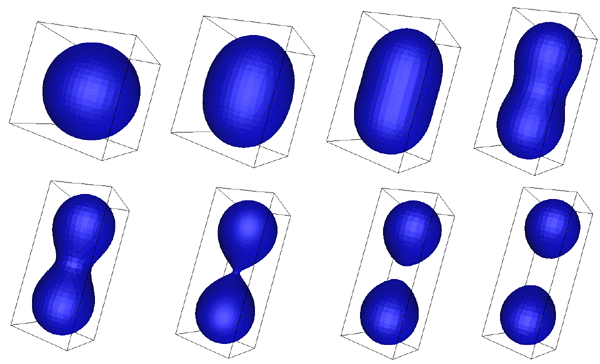
If the control structure is a line or a plane then the distance r is normally taken to be the closest distance to nay point on the line or plane. The following shows lines along the axis with varying field strength. 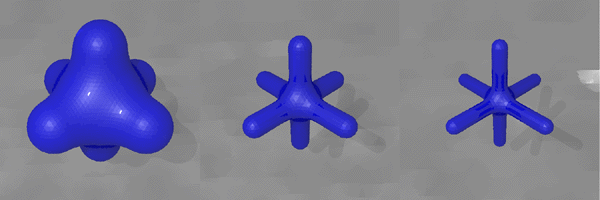
Blobby MoleculesPerhaps the earlier widely used field function is attributed to Jim Blinn and modelled after electron density fields.
"b" is related to the standard deviation of the curve, "a" to the height. The function should be recognised as a Gaussian curve centered at the origin, actually a half Gaussian as r >= 0. Meta BallsOne of the problems with the first example and blobby molecules is the field function extends to infinity, that is, to calculate the field at a point in space requires a summation of the contribution from each of the control primitives. This becomes computationally expensive as the number of control primitives increases. The next two field functions are bounded, after some distance from a control primitive they don't contribute to the field strength. 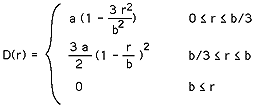
"a" is a scaling factor, "b" is the maximum distance a control primitive contributes to the field. Soft ObjectsThis field function is attributed to work by the Wyvill brothers, it is basically the first few terms in a series expansion of an exponential truncated to restrict the range of influence. 
"a" scales the function, each control primitive has no influence after a distance "b". This function has a slight advantage over that for Meta balls as it only uses squares of the distance and so it isn't necessary to compute square roots. Notes
People have known for a long time that if you have two implicit surfaces f(x,y,z)=0 and g(x,y,z)=0 that are fairly continuous, with a common sign convention (f and g positive on the inside, negative on the outside, say) then the implicit surface defined by f+g=0 is a blend of the shapes. The van der Waals surfaces of molecules (roughly speaking, iso-potentials of the electron density) are described in Chemistry and Physics books and [Max 1983]. To create animation of DNA for Carl Sagan's COSMOS TV Series, Jim Blinn proposed approximating each atom by a Gaussian potential, and using superposition of these potentials to define a surface. He ray traced these and called them "blobby models". Shortly thereafter, people at Osaka University and at Toyo Links in Japan began using blobby models also. They called theirs "metaballs" (or, when misspelled, "meatballs"). Yoichiro Kawaguchi became a big user of their software and their Links parallel processor machine to create his "Growth" animations which have appeared in the SIGGRAPH film show over the years. The graduate students implementing the metaball software under Koichi Omura at Osaka used a piecewise quadratic approximation to the Gaussian, however, for faster ray-surface intersection testing (no need for iterative root finders; you just solve a quadratic). Bloomenthal has discussed techniques for modelling organic forms (trees, leaves, arms) using blobby techniques (though he prefers the term "implicit modelling") and for polygonizing these using adaptive, surface-tracking octrees. The latter algorithm is not limited to blobby models, but works for any implicit model, not just blobs. Polygonization allows fast z-buffer renderers to be used instead of ray tracers, for interactive previewing of shapes. A less general variant of this algorithm was described in the "marching cubes" paper by Lorensen and some bugs in this paper have been discussed in the scientific visualization community in the years since. In the sci-vis community, people call them "iso-surfaces" not "implicit surfaces". Meanwhile, in Canada and New Zealand, the Wyvill brothers, and grad students, were doing investigating many of the same ideas: approximations of Gaussians, animation, and other ideas. Rather than "blobbies" or "metaballs", they called their creations "soft objects". But it's really the same idea. ReferencesD. RicciA Constructive Geometry for Computer Graphics Computer Journal, May 1973
Nelson L. Max
James F. Blinn
Jules Bloomenthal
Brian Wyvill, Craig McPheeters, Geoff Wyvill
Brian Wyvill, Craig McPheeters, Geoff Wyvill
Brian Wyvill, Geoff Wyvill
Fujita, T., Hirota, K. and Murakami, K
Tatsumi, H., Takaoki, E., Omura, K. and Fujito, H.
Chanderjit Bajaj and I. Ihm
Chanderjit Bajaj
Payne, B. A. and Toga, A. W
Graves, G.
Hart, J.
|
